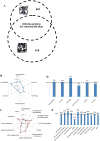Global analysis of the rat and human platelet proteome - the molecular blueprint for illustrating multi-functional platelets and cross-species function evolution
- PMID: 20443191
- PMCID: PMC4302335
- DOI: 10.1002/pmic.200900271
Global analysis of the rat and human platelet proteome - the molecular blueprint for illustrating multi-functional platelets and cross-species function evolution
Abstract
Emerging evidences indicate that blood platelets function in multiple biological processes including immune response, bone metastasis and liver regeneration in addition to their known roles in hemostasis and thrombosis. Global elucidation of platelet proteome will provide the molecular base of these platelet functions. Here, we set up a high-throughput platform for maximum exploration of the rat/human platelet proteome using integrated proteomic technologies, and then applied to identify the largest number of the proteins expressed in both rat and human platelets. After stringent statistical filtration, a total of 837 unique proteins matched with at least two unique peptides were precisely identified, making it the first comprehensive protein database so far for rat platelets. Meanwhile, quantitative analyses of the thrombin-stimulated platelets offered great insights into the biological functions of platelet proteins and therefore confirmed our global profiling data. A comparative proteomic analysis between rat and human platelets was also conducted, which revealed not only a significant similarity, but also an across-species evolutionary link that the orthologous proteins representing "core proteome", and the "evolutionary proteome" is actually a relatively static proteome.
Figures







Similar articles
-
Platelet proteomics.Mass Spectrom Rev. 2012 Mar-Apr;31(2):331-51. doi: 10.1002/mas.20345. Epub 2011 Oct 18. Mass Spectrom Rev. 2012. PMID: 22009795 Review.
-
Proteomic profiling of the thrombin-activated canine platelet secretome (CAPS).PLoS One. 2019 Nov 13;14(11):e0224891. doi: 10.1371/journal.pone.0224891. eCollection 2019. PLoS One. 2019. PMID: 31721811 Free PMC article.
-
The first comprehensive and quantitative analysis of human platelet protein composition allows the comparative analysis of structural and functional pathways.Blood. 2012 Oct 11;120(15):e73-82. doi: 10.1182/blood-2012-04-416594. Epub 2012 Aug 6. Blood. 2012. PMID: 22869793
-
Exploration of the platelet proteome in patients with early-stage cancer.J Proteomics. 2018 Apr 15;177:65-74. doi: 10.1016/j.jprot.2018.02.011. Epub 2018 Feb 10. J Proteomics. 2018. PMID: 29432918
-
The platelet proteome.Curr Opin Hematol. 2009 Sep;16(5):329-33. doi: 10.1097/MOH.0b013e32832e9dc6. Curr Opin Hematol. 2009. PMID: 19550320 Free PMC article. Review.
Cited by
-
Untargeted blood serum proteomics identifies novel proteins related to neurological recovery after human spinal cord injury.J Transl Med. 2024 Jul 17;22(1):666. doi: 10.1186/s12967-024-05344-y. J Transl Med. 2024. PMID: 39020346 Free PMC article.
-
Comprehensive Proteome Profiling of Platelet Identified a Protein Profile Predictive of Responses to An Antiplatelet Agent Sarpogrelate.Mol Cell Proteomics. 2016 Nov;15(11):3461-3472. doi: 10.1074/mcp.M116.059154. Epub 2016 Sep 6. Mol Cell Proteomics. 2016. PMID: 27601597 Free PMC article.
-
Presence and activity of Fibrinogen like protein 2 in platelets.PLoS One. 2023 May 18;18(5):e0285735. doi: 10.1371/journal.pone.0285735. eCollection 2023. PLoS One. 2023. PMID: 37200306 Free PMC article.
-
Platelets in Healthy and Disease States: From Biomarkers Discovery to Drug Targets Identification by Proteomics.Int J Mol Sci. 2020 Jun 25;21(12):4541. doi: 10.3390/ijms21124541. Int J Mol Sci. 2020. PMID: 32630608 Free PMC article. Review.
-
Identification of canine platelet proteins separated by differential detergent fractionation for nonelectrophoretic proteomics analyzed by Gene Ontology and pathways analysis.Vet Med (Auckl). 2014 Jun 21;5:1-9. doi: 10.2147/VMRR.S47127. eCollection 2014. Vet Med (Auckl). 2014. PMID: 32670841 Free PMC article.
References
-
- Ruggeri ZM. Platelets in atherothrombosis. Nat Med. 2002;8:1227–1234. - PubMed
-
- Mason KD, Carpinelli MR, Fletcher JI, Collinge JE, et al. Programmed Anuclear Cell Death Delimits Platelet Life Span. Cell. 2007;128:1173–1186. - PubMed
-
- von Hundelshausen P, Weber C. Platelets as Immune Cells: Bridging Inflammation and Cardiovascular Disease. Circ Res. 2007;100:27–40. - PubMed
-
- Sambrano GR, Weiss EJ, Zheng Y, Huang W, Coughlin SR. Role of thrombin signalling in platelets in haemostasis and thrombosis. Nature. 2001;413:74–78. - PubMed
-
- Jackson SP. The growing complexity of platelet aggregation. Blood. 2007;109:5087–5095. - PubMed
Publication types
MeSH terms
Substances
Grants and funding
LinkOut - more resources
Full Text Sources
Molecular Biology Databases

